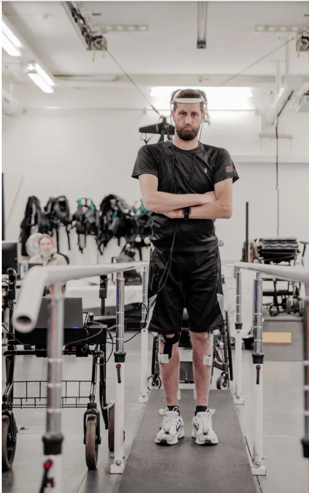Spinal Implants Are Making the Impossible Possible for Spinal Cord Injury Participants
 In a plot twist straight out of a science fiction novel, scientists have built a digital bridge between the brain and spinal cord, enabling a paralyzed man to walk naturally for the first time in more than a decade.
In a plot twist straight out of a science fiction novel, scientists have built a digital bridge between the brain and spinal cord, enabling a paralyzed man to walk naturally for the first time in more than a decade.
When Gert-Jan Oskam, 40, thinks, the system decodes his thoughts and translates them into movement through a brain-spinal interface (BSI). An implant in Oskam’s brain tracks his intentions to move and wirelessly transfers them to a second implant in his lower spine, creating natural movement.
“After several minutes of training, he was able to walk naturally using the system,” said Henri Lorach, a professor with the Ecole Polytechnique Federale de Lausanne, during a press briefing. “After using the system routinely, we observed functional recovery, including movement of the hip, knee, and ankle joints.” The research findings, published in May 2023 in the journal Nature, represent a giant leap forward to advance solutions for patients with spinal cord injury (SCI).
Advancing Complex Technologies
For years, scientists have been using implantable nerve stimulators to help patients with SCI recover function and movement. But without direct communication between the brain and spinal cord, the resulting movements were robotic, and patients were unable to navigate different terrain.
With the BSI, researchers have created a system that bypasses injured parts of the spinal cord, opening a door for patients with SCI to adopt a more natural stride. The dual-implant system captures Oskam’s thoughts and translates them into stimulation of the spinal cord to reestablish voluntary leg movement.
Oskam had tried stimulation procedures in the past, and even recovered some ability to walk, but each time, his progress plateaued. Oskam felt as if something outside of him was creating the movement. “With previous stimulators, the stimulator was controlling me,” he said, during a press briefing. “Now, I’m controlling the stimulation.”
The BSI provides Oskam with feedback when he moves, allowing him to traverse all kinds of terrain. He can climb stairs, pass over ramps, and decide when to stop and start walking. There’s even evidence that the BSI improves functional recovery. Earlier studies show that spinal stimulation can spur the growth of new neurons, and that appears to be the case for Oskam. More than a year after getting the implant, Oskam can walk with crutches, even when the system is switched off.
The Promise of Artificial Intelligence
The success of Oskam’s BSI experience relies on artificial intelligence, or AI. The research team implanted electrodes in Oskam’s skull and spine, then observed which parts of the brain lit up when he tried to move various body parts.

 In a plot twist straight out of a science fiction novel, scientists have built a digital bridge between the brain and spinal cord, enabling a paralyzed man to walk naturally for the first time in more than a decade.
In a plot twist straight out of a science fiction novel, scientists have built a digital bridge between the brain and spinal cord, enabling a paralyzed man to walk naturally for the first time in more than a decade.